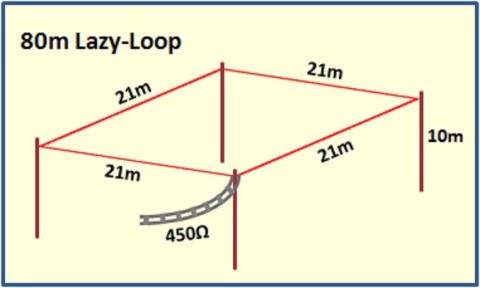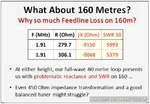My Favorite All-Band Antenna
IF I COULD ONLY HAVE ONE ANTENNA, THIS WOULD BE IT.
THIS PAGE IS STILL UNDER CONSTRUCTION.
If your goal is to work all or many of the bands, in my opinion, no other antenna matches this antenna for performance and reliability. Unfortunately you need a big space to deploy it. If you don't have a quarter acre (1000 sq. m) available for you antenna, look for something else. This one requires a lot of space.
Meet the Champion: The Lazy Loop (Sky Hook)
This antenna is a square horizontal loop, approximately 21m (69') per side, 84m (276') total length - though it is not critical when feeding with balanced feedline.
Although many people attempt to feed it with coax cable, I prefer to feed it with openwire feedline. This eliminates the need for exact pruning of the length, and besides, we can't get it optimized for ALL HF bands anyway. As long as you don't mind using an antenna matchbox for all bands, this is a great solution.
It requires 4 poles or elevated points and they should be about 10m (33') high. I assume it will still work well at lower heights, but I have usually installed it at 33 ft. When operating in Andorra in 1979, I had it hanging in trees at about 8m height. Performance was still very good.
The special thing about this antenna is, it has primarily high angle radiation on the low bands, 80 and 40m, yet low angle radiation on the higher bands. This makes it great for local communcations on the low bands, and at the same time great for working DX on the high bands.
I have used this antenna about 8 times during field day contests. In several of these operations we had either a 3-element trap beam, or 2-element quad. For transatlantic or transpacific contacts, the Lazy Loop was equally as strong as the directional antennas which were also mounted at 10m (33') height.
Despite its reputation as a "cloud burner" on the low bands, I have worked my fair share of DX on 80 and 40m with this antenna. This was my only CW antenna at my 1979 expedition to Andorra.
Some people try to feed this with coax. It can be done, but then the length of the loop becomes very critical. See the NC4Y Loop.
In the past, I preferred to feed it with 450 Ohm openwire feedline and match it with a good symmetrical matchbox, such as the Annecke Symmetrical Coupler.
In the meantime I have learned (tnx to W8JI, DF2BC, and DL1VU) that a 'good' asymmetrical antenna matchbox with an EXTERNAL 1:1 Guanella balun will work just as well, sometimes even better.
IF I COULD ONLY HAVE ONE ANTENNA, THIS WOULD BE IT.
Tim Hier, G5TM has modeled this antenna at two different heights: 10m and 12m, and created a YouTube presentation presenting his results.
Tim'smodelled results are shown in the Photo Gallery below:
PHOTO GALLERY:
Notes:
- "FP" shown in each graph marks the position of the feedpoint.
- The models are all modelled for 450 Ohms at the feedpoint (no feedline)
- The slides showing feedline loss were calculated using 50 ft. of 450 Ohm feedline.
Keep in mind that the impedences shown in the models above are at the feedpoint. Adding a feedline will change the impedance at the shack end of the feedline, but the radiation pattern remains unchanged.
Although I have used this antennas a dozen times at all sorts of locations, I have never modelled it myself, nor run any emperical tests on performance difference at different heights.
From Tim's modelling, there is not a whole lot of difference between erecting it at 10m height and 12m height, and like I stated above, I experienced good performance with this antenna at 8m height during my 1979 DXpedition to Andorra (C31SE).





































